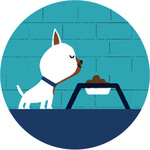If your dog has arthritis, don’t worry, you are not alone. Like humans, many pets suffer from arthritis – in fact, a fifth of all dogs show signs of arthritis by the age of one and, by the time a dog reaches eight years old, he has an 80% chance of having painful joints. But, while humans are prone to rheumatoid arthritis, dogs are more likely to develop a form of degenerative arthritis, due to wear and tear. The feelings of pain and reduced mobility are much the same, though, especially in elderly animals.
As your vet will probably have told you, medication, dietary supplements and prescription foods can all help, but you can also make life more comfortable for your dog with some simple changes around your home. Have a look at our illustration for some easy-to-apply ideas.


Cover tiled or laminated flooring with a non-slip runner or rug to prevent your dog from slipping or sliding. Arthritis causes inflammation of the joints and is very common in older dogs, where it can affect the legs, shoulders, neck, hips and spine. Although repeated slips and falls won’t necessarily make the pain of arthritis worse, it will affect your dog’s confidence and his general quality of life. Sliding unexpectedly can also cause muscular aches and pains.

Fit a stair gate at the bottom and top of the stairs to manage your dog’s access and help prevent accidental falls. Stiff joints can make climbing stairs much more difficult, especially when arthritis affects the lower back. Large or overweight dogs can feel particularly uncomfortable because there’s greater strain on the joints.

Use a portable ramp to help your dog climb in and out of the car – carry it in the boot so it’s there at both ends of the journey. You can also use a ramp if your dog has to climb a high step to enter the house.

Build a low platform or buy a simple stand to raise the height of your dog’s feeding and water bowls. Arthritis in the neck and lower back can make lowering the head very uncomfortable, so your dog will appreciate not having to bend down too far to eat or drink.

Invest in a set of portable, foldable ‘pet steps’ so that your dog can still reach his favourite spots, like the sofa or your bed. Older dogs with arthritis may also have issues with their eyesight, so being able to reach familiar places safely will make your dog feel more secure.

Ensure your dog has easy access to a soft, well-padded, open-sided bed in a warm spot. It should be much larger than your dog, to allow him to stretch out his legs when he’s feeling stiff, and to flop down suddenly without banging his elbows on hard edges or corners.

Place draught excluders behind external doors to block chilly draughts. When your dog becomes cold, his blood vessels constrict and similarly to humans, cold weather can make the pain and symptoms associated with arthritis worse.

Swap thin matting rugs for thick wool or plush materials to give your dog more support when he lies down. Animals with arthritis aren’t always able to lower themselves down gently, so any extra padding will be helpful.

Keep some puppy training pads near your dog’s bed in case he gets caught short, especially at night. Squatting can be very uncomfortable for pets with arthritis, so you may find your dog postpones going to the toilet until the very last moment. Be patient with any unexpected accidents, and encourage your dog to toilet regularly.
